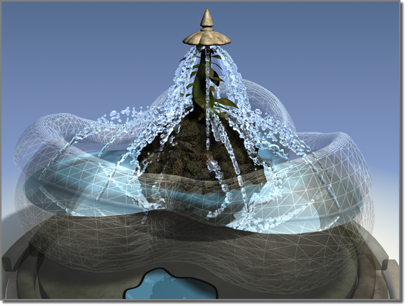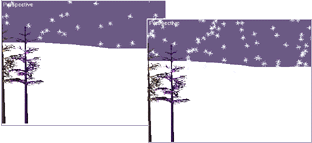Non-event-driven particle systems provide relatively simple, straightforward methods for generating particle sub-objects over time for the purpose of simulating snow, rain, dust, and so on. You use particle systems primarily in animations. 3ds Max provides six built-in, non-event-driven particle systems: Spray, Snow, Super Spray, Blizzard, PArray, and PCloud.

Fountain spray created as a particle system

Snowstorm created as a particle system
This topic describes only the general properties of particle systems. Other plug-in particle systems might be available in your configuration.
The built-in particle systems share these controls:
These parameters are also specific to the kind of particle system. There are options for displaying particles in viewports and rendering them in scenes and animations. Particles do not necessarily appear the same in renderings as they do in viewports.
You can modify and animate particle system parameters. You can also affect particle system behavior with space warps. In addition, you can deform particle systems with the Mesher compound object.
You create particle systems when you want to model an object or effect that can best be described as a large collection of similar objects behaving in a similar fashion. Obvious examples of such effects include rain and snow, but other equally valid examples include water, smoke, ants, and even crowds of people.
Spray simulates water drops such as rain, a fountain, the spray from a garden hose, and so on.
Snow simulates falling snow or confetti. The snow system is similar to Spray, but it has additional parameters to generate tumbling snowflakes, and its rendering options are different.
Super Spray emits a controlled spray of particles. This particle system is like the simple Spray particle system with the added power provided by all the newer particle systems.
This is an advanced version of the original Snow particle system.
Use the PCloud (or Particle Cloud) particle system when you want a "cloud" of particles that fill a specific volume. PCloud can provide a flock of birds, a starfield, or a troupe of soldiers marching over terrain.
The PArray (Particle Array) particle system can distribute particles on a geometric object. You can also use it to create sophisticated object explosions.